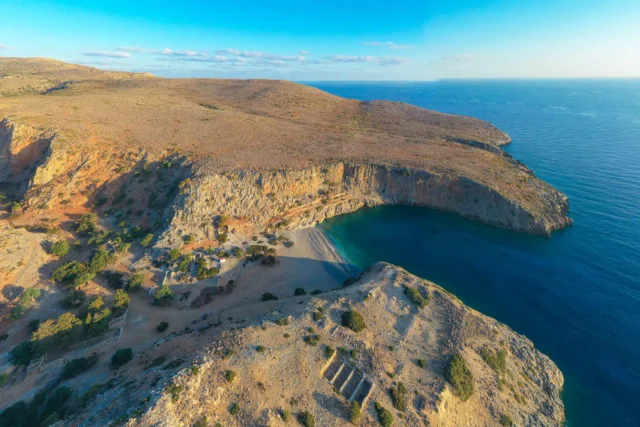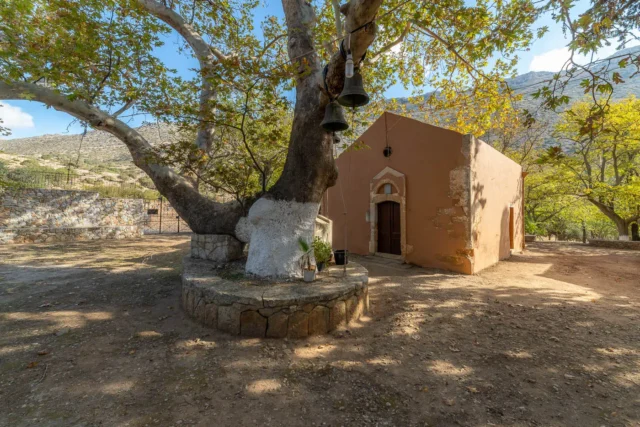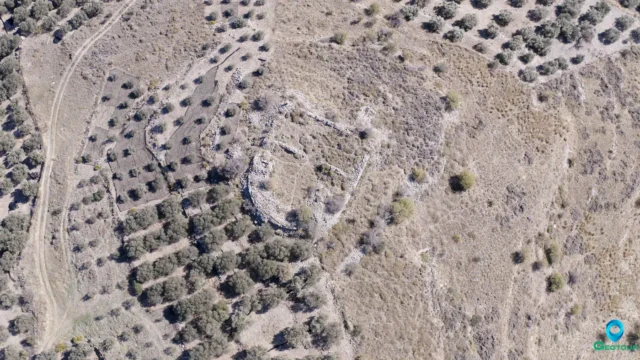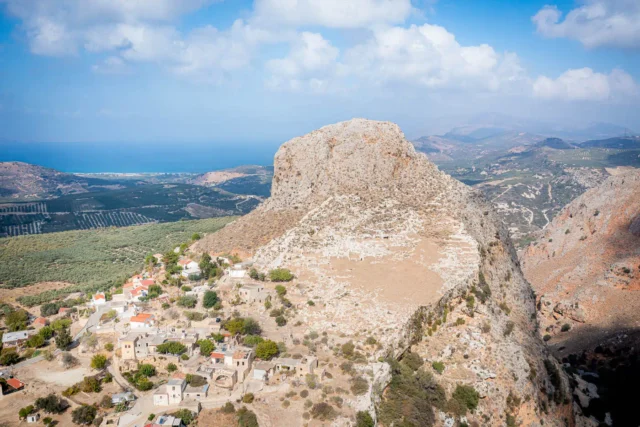52
listings found
Categories
Active filters:
Kournas lake
Crete's only natural freshwater body, this is a karstic lake in Apokoronas, Chania. Formed in a doline at the White Mountains' foothills, it is fed by underwater springs. A protected Natura 2000 site, its ecosystem includes native fish like the Sand Smelt and Freshwater Blenny, migratory European Eels, and the Balkan Terrapin. Introduced species like Mosquitofish and Goldfish, along with water abstraction for irrigation and potential pollution from tourism, pose threats to its delicate balance.
Fylaki, Apokoronas
Located in Apokoronas, Chania, at 100m altitude, this is a preserved settlement with roots in antiquity, evidenced by a Late Minoan tholos tomb (1370-1200 BC). The village was mentioned in Venetian records by Barozzi (1577) and Kastrofylakas (1583). Its name is believed to derive from Ottoman-era prisons, and remnants of these buildings still stand. Key sites include the historic 1930s Primary School. The local economy is based on agriculture and livestock farming.
Phylaki tholos tomb
A Late Minoan III (LM IIIA-IIIB) funerary monument in Apokoronas, West Crete, significant for understanding Postpalatial society after Knossos's decline. Excavated by Yiannis Tzedakis, this large tholos tomb features a rare rectangular chamber and a vertical lintel plaque, an architectural trait shared with the Malame tholos. Despite being partly looted, it contained rich grave goods reflecting elite status, including ivory carvings of a footstool and figures with unique almond-shaped eyes, and sixteen antique hard stone seals.
Agia lake
Located 9 km west of Chania, this artificial lake covers 45 hectares and was created in the 1920s from a swamp to power a hydroelectric station, now a museum. It is a significant Natura 2000 protected wetland, sourcing water from the White Mountains. The area is a vital stop for over 200 migratory bird species and hosts over 130 plant species. The native Cretan frog population has been largely displaced by the invasive American bullfrog. The site offers walking paths and birdwatching observatories.
Ancient Kissamos
The archaeological site, located in the ancient “Myrtilos” plain beneath modern Kastelli Kissamou, reveals occupation from the Minoan period. Initially the Hellenistic port for the inland city of Polyrrhenia, it grew into a major, autonomous Roman urban center (civitas libera). The Roman city featured a Hippodameian grid, luxurious villas with intricate mosaics, a theater, and advanced waterworks. Its prosperity ended with the 365 CE earthquake, which caused a tectonic uplift of up to nine meters, destroying the city and its harbor.
Chania, Chania
Located on Crete's northwest coast, this city boasts continuous habitation since Neolithic times on Kastelli hill, site of Minoan Kydonia. Its rich history layers Minoan, Greek, Roman, Byzantine, Arab, Venetian, and Ottoman periods. Known as "Venice of the East" during Venetian rule, which saw the construction of the iconic harbor, lighthouse, Firkas Fortress, and extensive fortifications. The Ottoman era added mosques and baths. It served as the capital of the autonomous Cretan State (1898-1913) and was central to the Battle of Crete (1941). The Old Town preserves Venetian and Ottoman architecture, while Halepa features Neoclassical buildings. Cultural traditions include Cretan music (lyra), dance, and cuisine. Museums like the Archaeological, Maritime, and Byzantine Collection preserve its diverse heritage.
The Church of Christ the Saviour in Temenia, Selino
The Church of Christ the Saviour is located in the Lazopouliana neighborhood in the village of Temenia, in the Selino region of Chania, Crete. This small church was built in […]
Ancient Elyros
Ancient Elyros, situated on Crete's 'Kefala' hill near Rodovani, originated in the Early Iron Age and thrived until Late Antiquity. Named after the mythical son of Apollo, it became a major urban center in southwestern Crete during the Classical period, known for trade and weapon manufacturing. As a leading city in the Oreioi League (formed in the 3rd century BC for security and economic reasons, including Hyrtakina, Lissos, Poikilasio, Syia, and Tarra), Elyros maintained external connections before the league's likely dissolution before 183 BC, a period when it was at war with Kydonia. The Roman era marked a time of flourishing for Elyros, evidenced by the "Philosopher of Elyros" statue. The city featured fortification walls, an aqueduct, cisterns, and a theater. Elyros minted its own coins, indicating autonomy, with emblems similar to Hyrtakina's. Its territory included the port of Lissos, a key economic contributor and religious center with an Asklepieion, as well as the coastal cities of Syia and Poikilasio. Archaeological findings suggest communication with mainland Greece, North Africa, and Southern Italy. Notably, Elyros had a local workshop producing unique glass pyxides. A rural sanctuary dedicated to Poseidon was also found in the 'Tsiskiana' area, likely under Elyros's jurisdiction.
The Ancient Port of Lissos
Lissos, an ancient Cretan port city, was a vital healing center and trade hub. It served the inland cities of Elyros, Hyrtakina, and Tarra. The sanctuary of Asklepios attracted pilgrims seeking cures.
Hyrtakina
Hyrtakina, an ancient Cretan city, thrived in the Oreia region near the White Mountains. As a member of the League of the Oreioi, it played a role in regional security and economic development. The city's strategic location on 'Kastri' hill was fortified by double walls. Hyrtakina's autonomy is evident from its unique coinage, featuring a wild goat and a bee. Trade connections extended to mainland Greece, North Africa, and Southern Italy, as shown by archaeological finds. The city's peak was in the 4th century BC, coinciding with its coin minting. Hyrtakina's agreement with Cyrene for grain supply highlights its interaction with other Mediterranean cities. The city was abandoned in Roman times.
Polyrrhenia: Fortifications and Acropolis
Polyrrhenia, an ancient city in western Crete near Kissamos, was occupied from the Iron Age to the Byzantine era. Its strategic hilltop location was protected by Hellenistic and Roman fortifications. The Acropolis featured a Byzantine castle, an early Christian basilica, and a potential temple to Artemis. A sophisticated water system, including an aqueduct with a defensive tower and underground reservoirs, sustained the population. The 19th-century Church of the 99 Holy Fathers incorporates ancient materials from the ruins.
Polyrrhenia
An Ancient City of Western Crete Polyrrhenia, also known as Polyrrenion, was a city in ancient Crete, located on the northern coast of the western part of the island . […]
The Archaeological Museum of Chania
A Journey Through Time The Archaeological Museum of Chania invites visitors on a captivating journey through the rich history of Western Crete, spanning from the Paleolithic era to the Roman […]
The Ancient City of Falasarna
An ancient city on western Crete, with history from the Neolithic (c. 3500 BCE) to its Roman conquest in 67 BCE. A fortified Hellenistic maritime power involved in trade and piracy, it rivaled Polyrrhenia. Excavations have uncovered a Temple of Demeter with Archaic Daedalic offerings and a 4th-century BCE fortified harbor. The harbor's towers were destroyed by the 365 CE earthquake. Today, the site is a protected archaeological park with ongoing research.
Minoan tholos tomb at Maleme
The Minoan tholos tomb at Maleme, Crete, is a remarkable example of Bronze Age funerary architecture. Located near the village of Maleme in western Crete, the tomb is known for […]
Rokka archaeological site
Located inland in Kissamos, western Crete, on the slopes of Troulli hill. This protected archaeological site dates to the Hellenistic period (4th-2nd century BC). Its identity is debated, possibly being the ancient city of Keraia or linked to the "Koinon ton Modaion." The settlement features unique architecture with houses, cisterns, and stairways carved into the limestone. A necropolis with rock-cut tombs has yielded artifacts. The modern village hosts the annual Giortes Rokkas festival to promote cultural heritage and repopulation.
Pergamos Ancient City
Pergamos (Πέργαμος) was a city of ancient Crete, founded in the 8th century BC. It was one of the hundred cities of Crete mentioned by Homer in his works. It […]
Katre, an Ancient City of Crete
Katre, an ancient city of Crete, is shrouded in mystery and intrigue. While historical and archaeological evidence about Katre is limited, its strategic location and mythological connections suggest a place […]

















